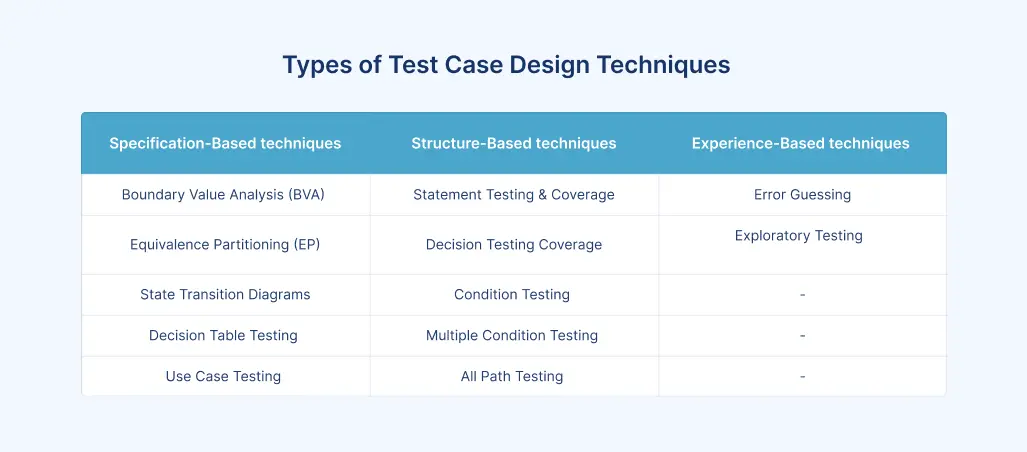
Software Testing Techniques help you design better test cases. Since exhaustive testing is not possible, Manual Testing Techniques help reduce the number of test cases to be executed while increasing test coverage. They help identify test conditions that are otherwise difficult to recognize. When combined with Automation Testing Services, these techniques become even more effective, allowing teams to optimize testing efficiency and consistency across multiple cycles.
Table of Contents
- Advantages of Test Case Design Techniques
- Specification-Based techniques
- Boundary Value Analysis (BVA)
- Equivalence Class Partitioning
- Decision Table-Based Testing
- State Transition
- Use Case Testing
- Structure-Based techniques
- Statement Testing & Coverage
- Decision Testing Coverage
- Condition Testing
- Multiple Condition Testing
- All Path Testing
- Experience-Based Technique
- Conclusion
Advantages of Test Case Design Techniques
- Test coverage: Test cases can provide comprehensive test coverage.
- Software quality: Improves the quality of software and user experience.
- Reusable test cases: They can be reused.
- Cost reduction: It reduces maintenance and software support costs.
- Software requirements: Test cases can confirm that software meets end-user requirements.

Let’s now understand the techniques in detail
Specification-Based techniques
Boundary Value Analysis (BVA)
- The method revolves around the concept of testing at the boundaries mid of partitions. Further, BVA covers various values such as minimum, maximum, inside & outside of the boundaries. It also includes error values along with typical values.
- In most cases, rather than the center, lots of errors are found at the boundaries. This is called Boundary Value Analysis (BVA) and it helps determine the test cases that focus on the bounding values.
Equivalence Class Partitioning
- Various techniques are made to bring quality and productivity to the software development process. With the provision of equivalence class partitioning, testers can divide the test conditions into a defined partition.
- Equivalence Class Partitioning divides the program’s input domain into classes of data that further help design the test cases. Here, testers can also identify the valid and invalid equivalence classes.
Decision Table-Based Testing
- The concept of decision table-based testing is followed when a function is required to respond to the various combinations of inputs. You can understand it better with an example. A submit button is executed only after checking if all the required details are filled or not.
- Another name of this software testing technique is the Cause-Effect table whose responsibility is to check the functions of the software where output depends on various combinations of input. If you have to test it across a large set of combinations, divide them into smaller units.
- While performing decision table-based testing, testers are required to create a table for every function. Mention all the possible combinations of inputs along with the required output. The step also eliminates the scope of errors that are overlooked during testing.
State Transition
- The fundamental concept behind state transition is changes made in input conditions affect the state of AUT (Application Under Test). Following the software testing technique, testers can verify the behavior of the application.
- Furthermore, state transition testing can be performed by entering multiple input conditions sequentially. To analyze the system’s performance, the QA team gives both positive and negative test values.
- A common query we have seen is, when should we use state transition? One should follow the method when the application is tested for a limited set of input values.
- Further, testers must implement the approach when there is a need to verify the sequence of the inputs or events.
Use Case Testing
- The concept of use case testing revolves around user experience. The look and feel of an application are visualized as an end user. All the functionalities are executed under various business environments. The aim is to make the application focused and result-driven.
Structure-Based techniques
Structure-based techniques are white-box testing, and test case design depends on the internal structure of the application. Here are the methods that are followed under the software testing technique:
Statement Testing & Coverage
The statement testing & coverage method ensures the execution of all the statements in the source code. Afterward, an analysis is made where the percentage of executable statements against the overall requirement is estimated.
Decision Testing Coverage
Decision Testing Coverage is also called branch coverage because, in this method, all branches corresponding to each decision point are executed at least once. The process makes sure that reachable codes are executed. Further, with the help of this testing method testers can validate the entire branch of the system. They can also assure that unexpected behavior of an application will not occur because of branches.
Condition Testing
You can also call this method Predicate Coverage Testing. Here the Boolean Expressions are determined either as False or True. Also, the outputs are validated at least once. Also, the method is recommended because it covers the entire code.
Moreover, the designing of test cases is done by considering the possible conditions so that they can be executed easily.
Multiple Condition Testing
To facilitate complete test coverage, the testing method focuses on testing various combinations of the conditions. Also, to ensure the outcome, more than two test scripts are needed. As a result, the method needs more effort to generate a great result.
All Path Testing
During all path testing, the entire code is considered to ensure all the executable paths. The testing approach helps to find all the errors or bugs available in the code.
Experience-Based Technique
The testing techniques and test case designs need experienced hands.
Error Guessing
As the name says, the testing is done by guessing the error. The software testing approach demands a great testing experience because only experts can find the bugs by guessing.
To execute the software testing mythology, make a list of errors. Imagine various scenarios and check the scope of errors that may create problems with the code. Afterward, write effective test cases to highlight the errors. Also, based on error guessing, the test case design should be based on past experiences, and this is the reason we need the best and most experienced tester to implement the method accurately.
Exploratory Testing
During exploratory testing, you do not need to have any documentation. The testing is performed based on the assumptions. The final intent is to offer the best user experience. Testers must think like users while designing the test cases.
Conclusion
Mastery of test case design techniques is pivotal for guaranteeing the efficiency and effectiveness of software testing. Acquiring knowledge of these testing methodologies empowers testers to craft intelligent test cases, enabling the identification of potential defects, steering clear of common pitfalls, and evaluating the performance and functionality of diverse software systems.
Elevate your testing capabilities with our expert guidance, as we stand as a leading software testing company committed to excellence. Our seasoned experts specialize in implementing cutting-edge test case design techniques, ensuring thorough evaluations that go beyond surface-level assessments.
About Author
 Shirish Tikli is an esteemed Quality Executive who commenced his professional journey in 2019 as a Software Test Engineer. He has adeptly navigated various career milestones, mastering new technologies and diverse tools and gleaning invaluable insights from past experiences.
Shirish Tikli is an esteemed Quality Executive who commenced his professional journey in 2019 as a Software Test Engineer. He has adeptly navigated various career milestones, mastering new technologies and diverse tools and gleaning invaluable insights from past experiences.
With a forward-looking perspective, he envisions stepping into a leadership role, aspiring to become a Team Lead/QA Manager and inspire teams toward excellence in quality assurance.


